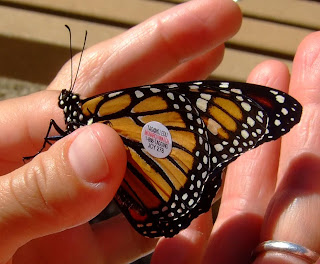I saw a few monarch butterflies on the move this weekend so it seems their southern migrations have begun. Monarchs east of the Rockies head to forested mountains in south central Mexico and those west of the Rockies journey to a number of locations along the California coast. The monarchs that start in eastern Canada migrate nearly 3000 miles--pretty amazing for an animal with a brain the size of a pinhead!
 |
| A tagged monarch--hope it gets found! |
With this year’s record-breaking heat and dry conditions across much of North America, monarch watchers will be taking a keen interest in their population. While it’s always tempting to make your judgment based on your individual experience (“I saw a lot fewer monarchs in my garden this year”), collecting hard numbers from a large number of people across their range is much more helpful. This is the way science works and monarch specialists invite everyone into the process!
In one of the world’s biggest “citizen science” initiatives, scientists,students and monarch enthusiasts of all ilks have been counting and tagging monarch butterflies for decades now. Want to get involved? JourneyNorth.org is a phenomenal monarch resource and provides lots of monarch information, the latest findings, and ways to report the monarchs you've seen. They even have an app to make submitting your sightings as easy (and COOL) as possible!
Ready for the next step? Order monarch tags from another great site, www.monarchwatch.org. “How does one tag a butterfly?” you ask. First, catch a butterfly (HINT:nets come in very handy) and then put the little tag, which is basically a round sticker, on the butterfly’s hind wing (in about the middle). While you need to get your catching and handling skills down, it’s pretty much as simple as that.
I know what you’re wondering: “Doesn’t it slow them down or make them fly in circles?” Scientists love monarchs at least as much as you do and they’ve made sure that the little sticker doesn’t harm or slow the insects down. As long as you handle your little insect friend gently they’ll be just fine.
Children as young as four year olds are known to participate. As a matter of fact, they say that children’s little digits may better suited to the task than big, grown-up fingers. Something like 2,000 schools and 100,000 children participate in this effort every year but the more the merrier.
Fewer than 1 in a thousand tagged monarchs are recovered so finding one is like winning a science lottery. If you’re the lucky one, make sure you contact the scientists with the date, location, weather conditions and any other information you think is important or interesting.
One more easy way to help is to create a “monarch way station,” a collection of plants the monarchs need during their life cycle. Native flowers will provide them with nectar, the sugary fuel adults need to energize their flights and some milkweed plants where mamas can lay their eggs. I hear mixed things about what they’re SUPPOSED to do in the fall but I have personally seen a lot of eggs left on my milkweeds in the fall so I say go ahead and put some out for them!
I know we’re all looking forward to the cool fall days ahead after the summer heat so get out there and look for those monarchs. If you’d like to try your hand at tagging them with me, I’m at Balcones Canyonlands Nat’l Wildlife Refuge between Austin and Marble Falls on October 13. I’ll play some tunes and help folks catch and tag monarchs. Come on out!